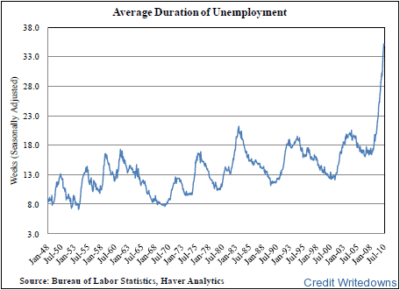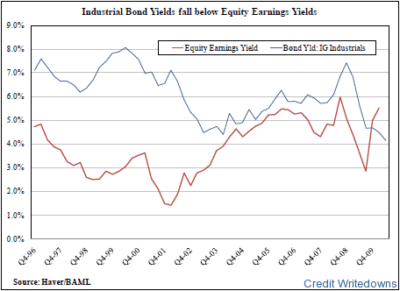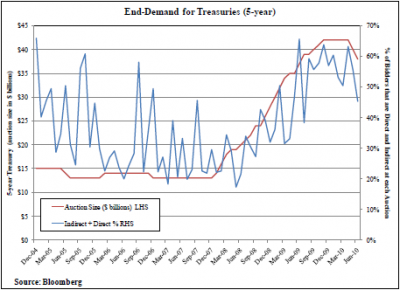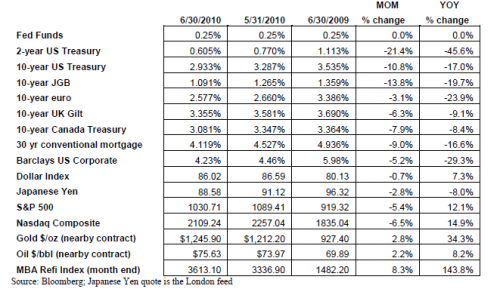Annaly: Soft Economic Data Has Meant Increased Risk Aversion
The July 2010 Monthly Commentary By Annaly Capital Management
The Economy
The S&P 500 finished June down 5.4%, while Treasuries enjoyed a significant rally. The yield on the 10-year shed more than 30 basis points and ended the month below 3% for the first time since April of 2009. This could be representative of a flight-to- quality bid, but it’s also likely a change in inflation expectations as CPI has now fallen for two straight months and broader measures of money supply have begun contracting on a year-over-year basis. Along with this recent bout of risk aversion, several other warnings began to flash during the month (more in our new Treasury market commentary below). The much-watched ECRI weekly leading index has taken a precipitous plunge in recent months, and is approaching levels not typically seen outside of recessions. The various purchasing manager indices and Federal Reserve surveys also suffered recent setbacks after periods of significant gains. The Institute for Supply Management’s manufacturing PMI survey dropped for the second month in a row, with the underlying sub-index for new orders falling to the lowest level of the year. The ISM non-manufacturing index also declined this month, with similar deterioration in the underlying sub-indices for business activity and new orders. The Dallas Fed’s manufacturing index surprised the market with a negative print during June, with similarly disappointing results from the Philadelphia Fed. "Double-dip" has recently become the over-used economic term du jour.
While it had no immediate effect on the economy, we must pause to reflect on the potential impact of financial regulatory reform. The Dodd-Frank Wall Street Reform & Consumer Protection Act had an eventful month as Congress raced to reconcile the competing House and Senate visions for the new financial landscape in time for a July 4 signing (they missed the deadline). The negotiation whirlwind was as much a civics lesson in how a bill becomes a law as it was an exercise in determining the best course of action. We’ll know more in 30 years whether that is what we got. But in the meantime, the regulatory reform bill al so throws a blanket of uncertainty over virtually every constituency in the marketplace. Ironically, the massive two-thousand-plus page bill was reduced to a series of short-hand code words and jargon in order to make the thing comprehensible—the Volcker Rule, derivatives and the Lincoln Amendment, bank capital and the Collins Amendment, consumer protection, risk retention, the bank tax—but even with the shape of the bill more or less final, many questions still remain about execution. How will the Volcker Rule change the hedge fund and private equity business? How will counterparties evaluate swaps dealers if they are in bank holding companies? How much capital will be required for new margin and collateral requirements on exchange-traded and cleared derivatives? Will valuations on trust preferreds suffer if they don’t count as bank capital for medium and large banks? What will the new risk retention rules do to the securitization market? And how much of all this will be reversed down the road? Uncertainty lingers, and the markets will adapt, but only time will tell if this bill actually accomplishes its objective of reforming Wall Street and protecting consumers.
The real way to protect consumers is to give them job opportunities, and on that front the employment situation has begun to falter. While declining from the worst levels of the recession, weekly initial jobless claims have settled in recent weeks in the uncomfortable range of 460,000-470,000, a level still consistent with ongoing job losses. Non-farm payrolls had been inflated by hundreds of thousands of temporary Census jobs over the last several months, so data watchers waited to see if the private sector could pick up the slack as these government jobs began to disappear. The report showed a total nonfarm payroll decline of 125,000, due to Census job cuts of 225,000. Total private sector job growth came in at +83,000, with service-providing sectors adding 91,000 jobs and goods-producing sectors losing 8,000 (in line with the roll over in manufacturing and PMI surveys mentioned above).
The unemployment rate improved to 9.5% from 9.7% in the previous month, and 9.9% in the month before that. While it’s encouraging to see this number improving, the way that it’s improving is worrisome. Over the last two months the number of unemployed people fell by 637,000 (good!). However, the number of employed people also fell, by 336,000 (not good!). This means that the number of people who are unemployed is shrinking but not because they are getting jobs; they are just taking themselves out of the labor force. In the last 12 months, three million additional people have decided to take themselves out of the labor force. Moreover, if unemployment benefits are not extended by Congress, another two million claimants will lose their benefits by the end of July, and it is likely that a portion of those will select themselves out of the labor force, too.
The Household survey portion of the Bureau of Labor Statistics report gives us a clue about why people might be leaving the work force: the mean duration of unemployment is now at a record 35.2 weeks, a statistic that has lately gone parabolic.
The Residential Mortgage Market
Prepayment speeds in May (June release) for 30-year Fannie Mae mortgage-backed securities increased 11% month over month, largely due to the Agency’s delinquency buyout program. In contrast, Freddie Mac, which concluded its buyout program last quarter, reported speeds on its MBS declined 12%. The majority of the increases in Fannie Mae collateral were in pools with coupons of 5.0% to 5.5% as Fannie Mae has been sequentially buying out loans in decreasing coupon order (6.5%+ in March, 6% in April, 5% to 5.5% in May). Thanks to these involuntary prepays, speeds in 30-year 5s increased to 28.3% in May from 15.2% in April and 5.5s increased to 47.1% from 22.1%, while 6s decreased from 67.7% to 27% reflecting their post-buyout behavior.
Looking ahead, and with the majority of the buyout program completed and only 4.5s and below remaining, prepayment speeds are estimated to be tame given the current level of rates. According to the research team at Morgan Stanley: "While ongoing delinquent loan buyouts are likely to continue, it is the lack of voluntary prepays that is the dominant theme in prepays with overall prepay speeds especially amongst higher coupons that remain low especially when viewed at historic lows in mortgage rates. The lack of home equity and tougher underwriting standards explain the low voluntary prepay speeds." The Morgan Stanley analysts expect further housing price declines on the order of 5% to 8% nationwide in 2010, which should continue to mute prepayment behavior going forward.
During the month of June there were two important policy decisions, one by Fannie Mae and the other by the New York Federal Reserve, which could have lasting implications for Agency mortgage-backed securities. The first came on June 23rd when Fannie Mae announced increased penalties for borrowers who walk away or "strategically" default on their mortgages. According to their release, "Defaulting borrowers who walk-away and had the capacity to pay or did not complete a workout alternative in good faith will be ineligible for a new Fannie Mae-backed mortgage loan for a period of seven years from the date of foreclosure." Additionally, Fannie Mae will take legal action to recoup the outstanding mortgage debt from borrowers who strategically default where allowable by law. Freddie Mac is thought to be considering a similar policy. The second policy decision came on June 28th as the New York Federal Reserve announced their "intention to engage in coupon swaps to help facilitate delivery of approximately $9.2 billion in currently unsettled thirty-year Fannie Mae 5.5% pools." The New York Federal Reserve plans to "swap unsettled Fannie Mae 30-year 5.5% coupon securities for other Agency MBS that are more readily available for settlement," according to the release. This would potentially ease the "fail" problem present in the system which was created by the Fed’s purchase program which we spoke about in our last commentary. According to Barclay’s, the Fed is most likely to engage in swapping Fannie Mae 5.5s for Fannie Mae 4.5s as they have the greatest float, the highest new issue volume and will likely have a shorter duration than lower coupons. As a result of these two new policy decisions Agency mortgage-backed securities should stay well bid for the foreseeable future: the Fannie Mae announcement should lead to lower involuntary prepayments, and the Fed’s decision means the largest buyer in the space has its sights set on the fattest part of the coupon stack.
The Commercial Mortgage Market
In June, the Commercial Mortgage Securities Association, renamed the Commercial Real Estate Finance Council ("CREFC"), held its annual convention in New York. Although the organization’s name changed, the topics covered were mostly the same ones discussed at their January conference, including market fundamentals, debt capital supply and providers and regulatory reform. However, the main topic of discussion at the conference remained commercial mortgage securitization and all the attendant issues that accompany it such as warehousing, collateral composition, structuring and regulatory impact. To that end, we detected skepticism or, at best, resigned acceptance on the part of investors to the ongoing competitiveness of CMBS. This month we explore some of the more contentious issues that were discussed during breakout sessions between investors and issuers.
A draft document has been circulated entitled, not surprisingly, "Best Practices for CMBS Restart." The document has two themes: alignment of interests and transparency.
Alignment of interests, which is also being reviewed in the context of the larger securitization market, is a relatively straightforward concept. Namely, the party that originates a long-term asset such as a commercial mortgage should maintain a vested interest in the performance of that asset over its life. A minimum risk retention of 5% has been suggested. We note that it may raise the cost of execution with borrowers due to accounting consolidation requirements (FAS 166/167) and the requisite capital reserves imposed on those originating and retaining the risk. The Dodd-Frank bill has a provision allowing that the B- piece buyers/owners who conduct due diligence and consolidate the transaction essentially own the risk and thus exempt the issuer from having to retain it. This would have the overall benefit of limiting the execution cost to the issuer and borrower.
The issue of transparency is divided between pre- and post-securitization periods. Historically, only the non-investment grade buyer received loan level information prior to securitization, but now investment-grade investors are asking for similar information. The recommendation is not unreasonable given aggressive underwriting and lax oversight by the rating agencies prior to the credit bubble bursting. One sensed, however, that investors were seeking not just additional disclosures, but a greater level of comfort in future collateral performance.
CMBS post-securitization reporting has always been recognized as a model of transparency among the different types of asset- backed securities. However, there are various data fields in the reports that go unfilled or are reported in an un-standard fashion. The Best Practices document supports better disclosure. In certain but not all situations this will help investors to better evaluate the securities, but it would also add to the execution costs.
Clearly there is a tension in regulatory reform. While investors’ recommendations for best practices are understandable, additional disclosure coupled with added financial and accounting regulations may result in a better designed product, but it likely will also be more expensive. An unintended outcome of these machinations may be to create more private, and thus less regulated, transactions.
The Corporate Credit Market
Ahead of the second quarter earnings season, paralysis and risk aversion are prevailing themes in corporates. One does not have to look too hard for the evidence. Investors are trading less, selling bonds, and improving portfolio quality. More precisely, monthly trading volumes are down 46% from this year’s peak, money is flowing out of high yield funds, and the highest quality corporates have outperformed their riskier peers. Concurrently, firms continue one of their most popular financial strategies of late: hoarding cash. Moreover, mid-cycle risk-taking activities such as M&A, the gearing up of capital expenditures and even returning cash to shareholders in the form of higher dividends and share repurchases have fallen short of the promise implied by the spring’s catapulting S&P 500 index. Collectively, this risk aversion and paralysis has caused credit to outperform equities in the sell-off.
One consequence of recent market behavior is a material shift in relative valuations between debt and equity. First, changes in demand preferences in the post credit crisis era have supported the performance of debt. Perhaps the most nimble of asset allocators, mutual fund investors, have been buying fixed income and selling equity since 2008. Likewise, corporate defined benefit plans migration toward liability driven investment (LDI) has resulted in a shift towards fixed income. Most recently, the prevailing force behind the demand and performance of fixed income is the growing recognition of a deflationary U.S. economy. The recent rally in the 10-year Treasury yield to below 3% is the best evidence of the sentiment shift. With respect to credit, the higher quality the bond the more it gets taken along for the ride.
Flows are also simply chasing returns. Market pundits make numerous analogies to the U.S. outlook being similar to the Japanese experience. Return data for U.S. equities tell us that the "lost decade" has already come to pass. On the bond side, the multi-year disinflation trend has captured declining nominal yields. In the table below, we compare the returns of the S&P 500, the Bank of America Merrill Lynch Fixed Income Domestic Aggregate (Treasuries, mortgages, Agencies, and investment grade corporates) and the BAML High Yield Bond Index. Over the past 10 years, for example, stocks have produced annualized losses of 1.6%, whereas the fixed income and high yield benchmarks have returned 6.5% and 7.4%, respectively. In the table, we also present the CPI index in a CAGR context. Clearly, the secular disinflation trend has supported the long-term performance of fixed income assets. At a time when there appears to be widespread capitulation on the rate front, it’s important to ask "what next"? One thing we know about bonds is that their returns are bounded by the fact that yields can only fall to zero. Total return is composed of price and income returns, thus with the Domestic Aggregate Index yielding 2.25% and priced at $107, one must ask about the upside.
Another way to assess relative debt and equity valuation is to compare bond yields to the earnings yield of equity— the inverse of the P/E ratio. Normally, equity earnings yields trade below their bond yield counterparts as investors are willing to accept lower yields for the positive optionality of owning equity. In the graph below, we show the earnings yield for the industrial component of the S&P 500 versus the yield on BAML’s investment grade index for industrial bonds. The yield for the latter benchmark has fallen to 4.14%, thanks in part to the Treasury rally. Hence for the first time in our history, bond yields have fallen below earnings yield for high quality firms. Note that this is not the case in high yield as yields have been more linked to the performance of equity in recent months. From an investment-grade company’s perspective, the cost of debt has never been so cheap both on an after-tax basis and relative to equity. Based on this relative pricing, it is highly likely the second half will be a time when firms "take action" with respect to their capital structures by either buying back shares or issuing debt to fund M&A.
The Treasury/Rates Market
The Treasury market continued its impressive rally in June as stocks faltered and the flight-to-quality bid came roaring back. Since early April, the yield on the 10-year Treasury has rallied over 100 basis points. We saw the important 3% level broken on the 10-year as well as 4% on the 30-year. Treasuries have continued to take their cue from the rest of the market as participants shied away from riskier assets. The two-year yield reached an all-time low of 0.59% on June 29th, marking levels not seen since the previous low was set in December 2008 during the darkest days of the subprime crisis.
June auction demand continued to be strong as the Treasury sold $178 billion in notes and bonds. The auctions went well despite the increasingly lower yields. Even with the euro trading roughly flat on the month, global demand for safe haven US Dollar- denominated assets was quite evident. The chart below helps demonstrate the healthy demand for Treasuries despite the abundant supply. End demand here is represented by the sum of the "takedown" from participants excluding primary dealers, specifically "indirect" and "direct" bids. Quarter-end balance sheet pressures also contributed to the grab for Treasuries, yet at the time of this writing there has been little relief as the new quarter unfolds.
On June 23rd, the FOMC reiterated that conditions "warrant exceptionally low levels of the Federal Funds rate for an extended period." The statement read quite dovishly as the committee softened the language related to the inflation outlook. As a result, the front end of the yield curve performed exceptionally well for the first half of the month keeping pace with longer maturities. Investors have seemingly become quite confident in the notion of the Fed on hold for a substantial period of time as evidenced by two-year yields. Economists, too, are adjusting their expectations, as many major financial institutions have pushed back their forecast for the first rate hike. (See our blog post on this topic, A Flock of Fed Funds Forecasts.) Ultimately, however, the front end began to stall relative to longer maturities and the yield curve flattened as the 10-year saw the greatest gains, marginally outperforming the five-year and the 30-year. If the rally is to continue, the curve likely will flatten further.
The Markets
Yet again, June was a good month to own bonds and gold. The rally in the dollar took a breather, while stocks continue to decline. The MBA Refi Index only grudgingly moved up as mortgages remained at historic lows.





Annaly:
You make an important observation but fail to provide true understanding of the depth of the observation
You say that for the first time in “our history” debt yields are below equity yields. You only show us a graph dating back to 1996 (very recent history indeed). How far back in data did you look? If you say “our history” you should be looking back at least to the Great Depression. Care to clarify??
Making a sweeping statement such as “for the first time in our history” merits a more thorough explanation. Dont you agree?